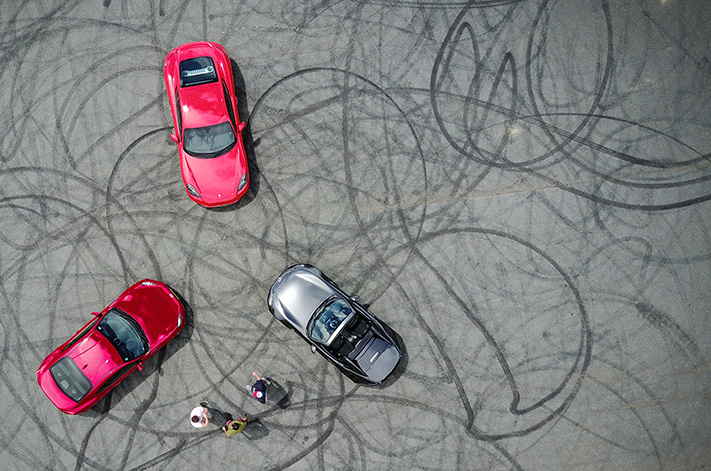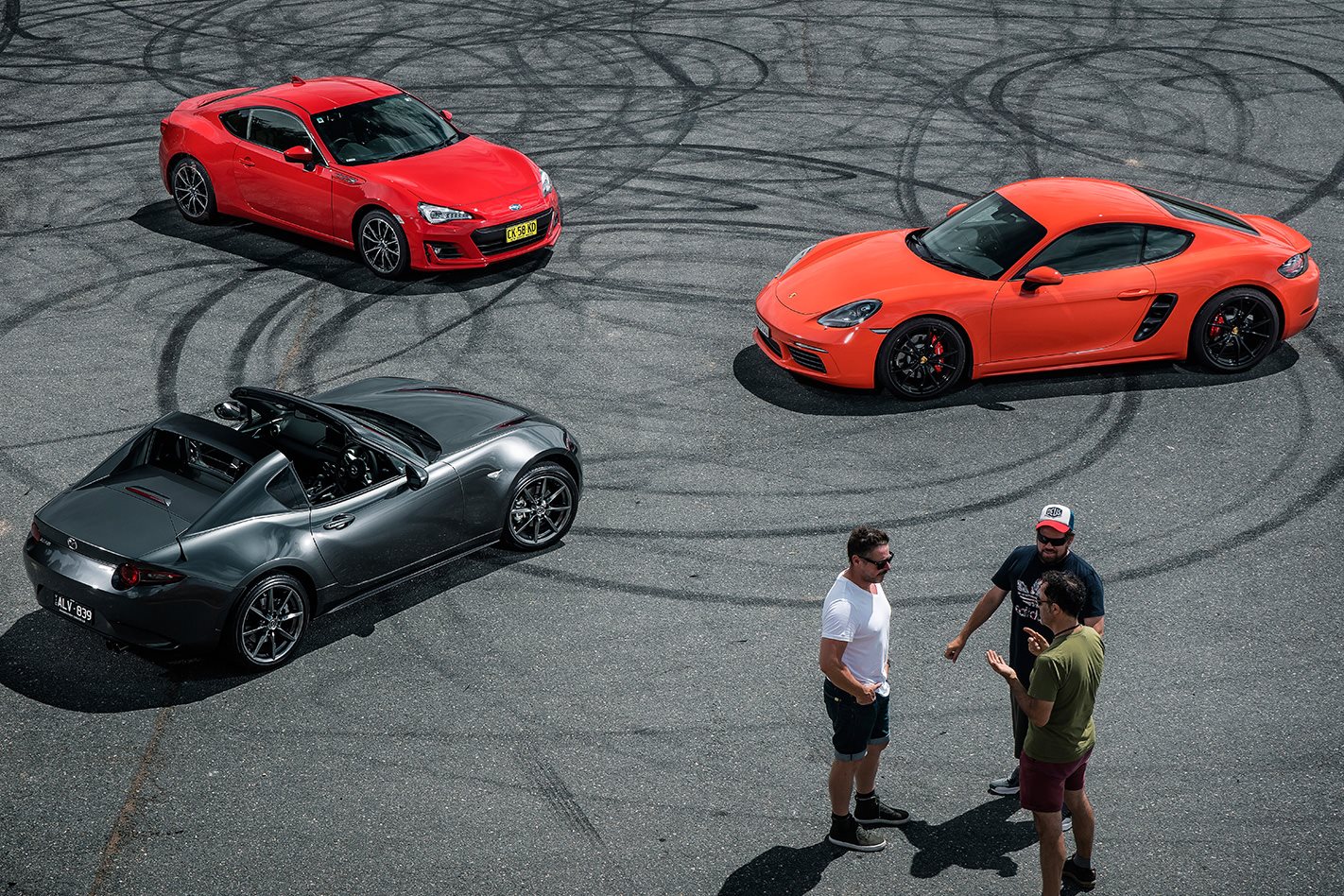CONNECTIVITY is the buzzword of a generation, built on instant gratification and unimpeded interaction with the world at large, yet there’s an ironic, gaping hole in all of this.
First published in the May 2017 issue of Wheels Magazine, Australia’s most experienced and most trusted car magazine since 1953.
We’re being fed communication by the continent load, yet we’re craving taller, less intimate vehicles that lift the driver up from the road, beyond lesser mortals, further from the point of connection.
But not the three superstars you see here – Mazda’s freshly targa-roofed MX-5 RF, Subaru’s exquisite BRZ and Porsche’s now-ballistic, turbocharged Cayman S.
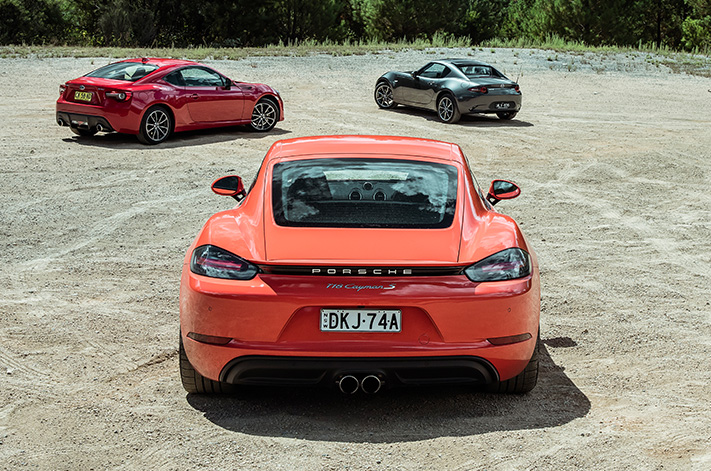
The caveat, of course, is extracting yourself from their low-slung cabins while maintaining a shred of dignity, but if you have to ask…
We could’ve invited other sports coupes to the party, like Ford’s hugely popular Mustang and maybe even a BMW 2 Series, but that would be missing the point of the MX-5, BRZ and Cayman experience.
Each represents the definition of motoring purity in 2017, and it’s no coincidence that each houses its engine inside the wheelbase. In the Mazda and Subaru, it’s front-mid placement while the Porsche is a true mid-engined sports car.
There’s some back story here too. In our June 2012 issue, we sent Peter Robinson to Japan to compare the BRZ’s near-identical sibling, the Toyota 86, with Porsche’s previous-generation 987 Cayman flat six, prompting the hugely controversial cover line ‘Toyota beats Porsche’.
“A brilliant and charming enthusiasts’ car; one that tops the Porsche in this comparison”, wrote Robbo. But where do we stand five years hence?
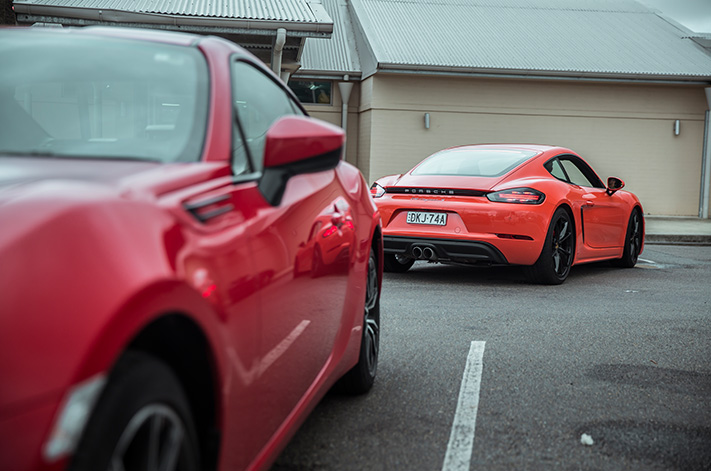
Following a complete generational change in late-2012, Porsche almost started again with last year’s 718 Cayman. Only the bonnet, windscreen, roof and tailgate are carried over from the 981 Cayman, while engine-wise, the revered atmo flat-six has stood aside for an all-new boosted flat-four, measuring 2497cc in the case of this range-topping S, not 1988cc like the base Cayman we wanted for this test.
But hey, who could turn down a Lava Orange Porsche wearing black 20s, looking like a slice of Gold Coast bikini chic from the late-’80s?
Packing a variable-vane turbocharger (as per 911 Turbo) and enough muscle to dramatically re-write the rulebook for ‘entry-level’ Porsche performance, the Cayman S is truly supersonic. With launch control aiding traction, the dual-clutch Porsche leaps off the line like a barking pit-bull and strains at the leash virtually to its top speed of 285km/h.
In just over four seconds, the Cayman S is travelling 30km/h faster than the BRZ and MX-5, nailing triple digits in 4.3sec and flashing past the 400m mark in a rip-snorting 12.4sec (at 187km/h).
That’s a level of acceleration that would’ve once been a 911 Turbo’s exclusive domain, yet here we have a brattish little four-potter matching its grand-daddy’s brutishness.
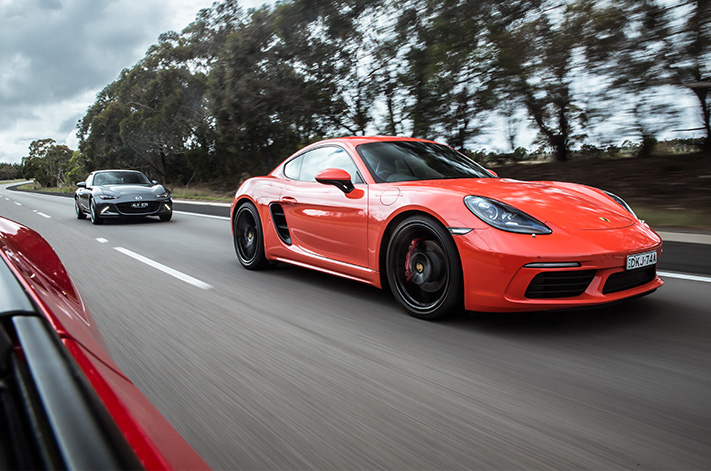
Up against the cream of Porsche’s Cayman crop, the BRZ and MX-5 RF are left reeling. The Cayman S will sprint to 160km/h in half the time it takes the BRZ (9.2sec versus 18.0sec), while an upshift to fifth gear at exactly that point means the MX-5 is slower again (19.4sec). But there’s still a sizeable chunk of sports-car spirit in the charismatic Japanese pair.
Bolstered by snick-snick manual gearshifts and an insatiable desire to rev, both the Subaru and Mazda reward redline commitment.
The BRZ’s direct-injection 2.0-litre flat four has been thoroughly tweaked for 2017 to extract a bit more power and torque in manual-transmission models, yet it feels little different to before. The alterations haven’t banished a curious lull in its power and torque delivery between 4000 and 4500rpm, though the fact the engine suddenly comes alive at four-five probably exacerbates the experience.
Beyond 4500rpm, the BRZ exponentially dials up the intensity until it snags its ignition cut-out at 7400rpm – just like the much-missed atmo Renaultsport Clios used to – supported by a sharp induction rasp amplified by a sound symposer plumbed from intake to firewall.
But the low-mileage test car never felt as elastic as we remembered, and its numbers proved as much – it clocked a modest 7.8sec to 100km/h (Subaru claims 7.4sec) and 15.5sec to 400m, or about as quick as a warm hatch like the Mazda 3 SP25.
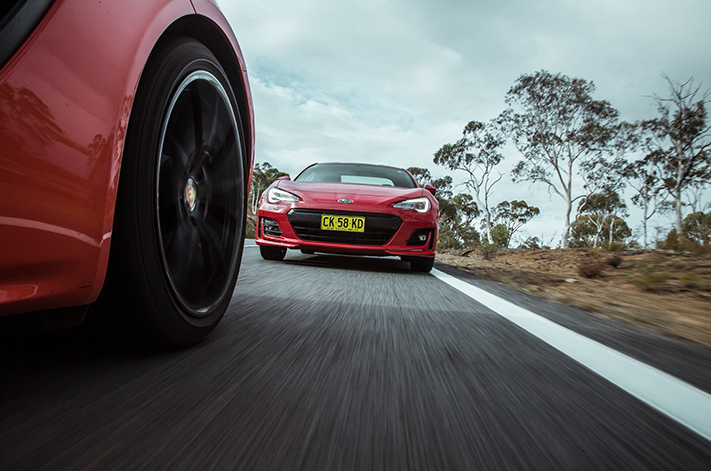
But there’s a lot to like in the RF.
Weighing just 1080kg (compared to 1282kg for the BRZ and 1385kg for the Cayman S PDK), the tin-top MX-5 is saved by its power-to-weight ratio, and much of the time, it feels torquier than the Subaru.
There’s a throaty muscularity to its induction note, too, that fits the sporting bill perfectly, and a rev ceiling of 6950rpm is still plenty in a delicate little coupe like this. You have to work hard for your performance rewards in the Mazda and Subaru, yet the Porsche, too, withholds its true accelerative brilliance for the deeply committed, or deeply insane.
Rev the absolute tits off the BRZ and MX-5 and you’ll still be only a decisive brake stab away from something approaching a legal speed.
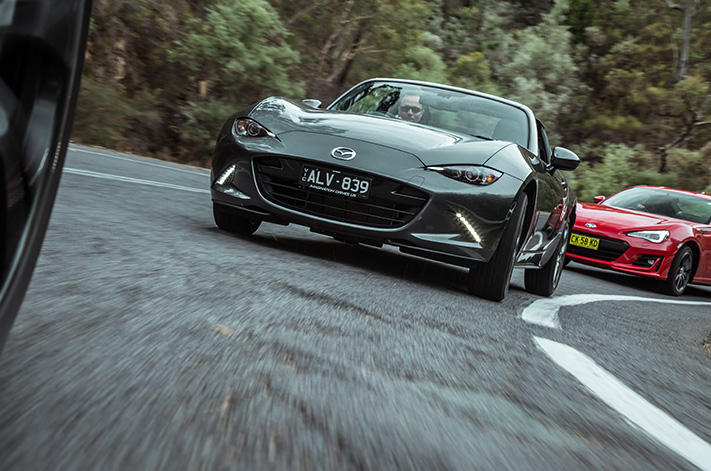
If you keep the throttle pinned long enough, it will keep piling on the artillery right to its 7400rpm redline, just like the old flat-six used to, but on another level altogether.
It’s breathtakingly quick, with a throbbing, pulsing, cackling backing track courtesy of an optional $4330 sports exhaust in this instance, yet the Cayman S PDK is tractable enough to lend to your granny for a trip to the shops.
It also has the dynamic dexterity to harness every fragment of its 257kW and 420Nm engine outputs.
Indeed, the Porsche’s blend of precision, control and comfort is really quite astounding.
On the punishing Cotter Road outside of Canberra – a fabulous test route blessed with both a 100km/h limit and more lumps, bumps and curves than a Sports Illustrated calendar – the Cayman S demonstrated the worth of its cutting-edge (and expensive) mechanical set-up.
Featuring Porsche Torque Vectoring (with a mechanically locking rear differential – $3190) and Porsche Active Suspension Management (adaptive dampers) with ride height lowered by 10mm ($2710), as well as 20-inch Carrera S alloys wearing Pirelli P Zero rubber, the Cayman S operates on a much higher plane than the BRZ and MX-5.
Even with its suspension in default mode, the Cayman’s body control is superior to the Japanese pair, but in Sport mode the difference is even more remarkable.
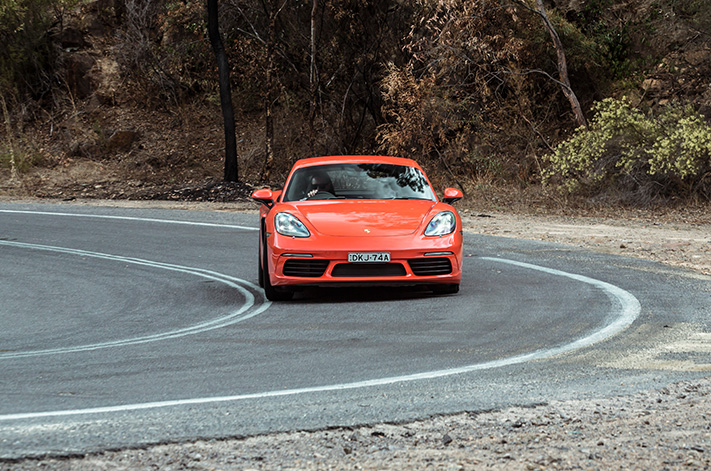
Benefitting from the tangible strength of the Cayman’s body structure, the Porsche’s damping is perfection.
It’s a rare Sport mode that can be used effectively on an Aussie country road, with steering and fingertip connection amped up to suit, yet the Cayman S pulls it off with almost arrogant conviction.
And its brakes – ventilated and cross-drilled discs clamped by four-piston calipers – are stunning, pulling up from 100km/h in just 31.7m.
In comparison, the MX-5 managed a still-decent 35.5m while the BRZ (with slightly mushy pedal feel unless you’re really into the travel) stopped in a pretty average 38.4m.
More so than the previous 987 generation, there’s a 911-esque flavour to the Cayman’s dynamics that rewards technique and commitment. You need to be decisive on turn-in, feeding in plenty of lock, but when you do it transfers load onto the rear axle instantly, enabling you to carve a line through a corner – bumpy or smooth – almost like a sculptor.
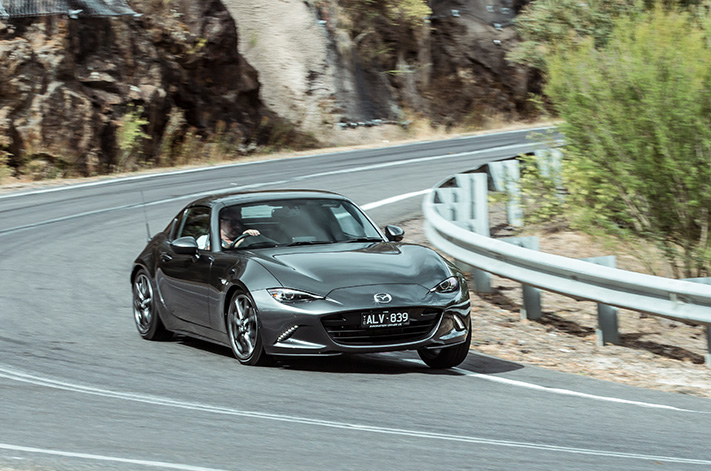
Like the Porsche, the boxer-engined Subaru resists bodyroll much more than the almost comical MX-5. And like the Porsche, the BRZ’s work station is texbook brilliance, with perfectly aligned pedals, and the best steering wheel and driver’s seat here (complete with a plush headrest that can be reversed to make room for a helmet on track days), despite the cloth-trimmed bucket’s rudimentary lever backrest adjustment.
In fact, the BRZ’s seats form a major part of its rough-road comfort. They’re masterfully in tune with what’s raging beneath, though the BRZ’s tightly damped chassis can feel a little twitchy over bumps.
It’s more of an amusement ride than the Porsche and Mazda on Cotter Road, with lots of grin-inducing movement in all directions, but its body control is terrific and its new Track ESC setting is subtle enough to monitor oversteer subtly and proficiently.
Ultimately, it’s a bit skittish on a road like this, but once you learn to trust it, it’s rarely unsettling. And the BRZ’s steering – just the one setting, beautifully weighted, crisp and communicative – is of a standard that should be automotive engineering 101.

Once you’ve settled an MX-5 onto its back end in a corner, it’s virtually all throttle steer from there. So delicious is its fluidity and suspension pliancy that you can drive it flat out virtually everywhere, without the cocktail-shaker effect of the BRZ over lumpy surfaces, and boy does it love to lean! Personally, I think well-balanced bodyroll is right up there with great margaritas and rude graffiti in terms of life’s little pleasures, yet the MX-5’s lateral attitude doesn’t inhibit its cornering speed or outright grip.
Not on the road.
Where the lightweight MX-5 requires some compromise is inside its intimate cabin. The by-product of its exquisite form and diminutive size is not a whole lot of room for larger frames.
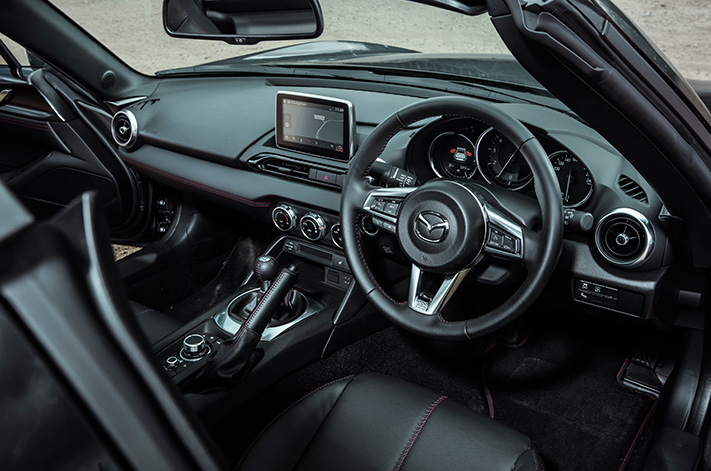
It can’t match the in-cabin refinement of proper coupes, either. The MX-5 RF is a tin-top roadster convertible, and providing you view it that way, then you’ll understand why its cabin sounds slightly hollow, as if you’re closer to the elements than you are in the Subaru and Porsche.
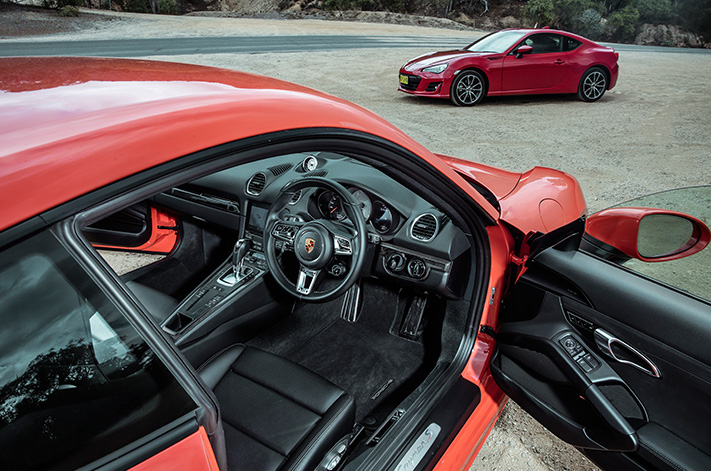
While they’re best suited to legless twins, the fact you can actually put kids in there awards the BRZ a liveability prize that makes it a genuine option as a second family car. You can even fold its rear backrest down to squeeze in a bicycle, and it has a spare wheel.
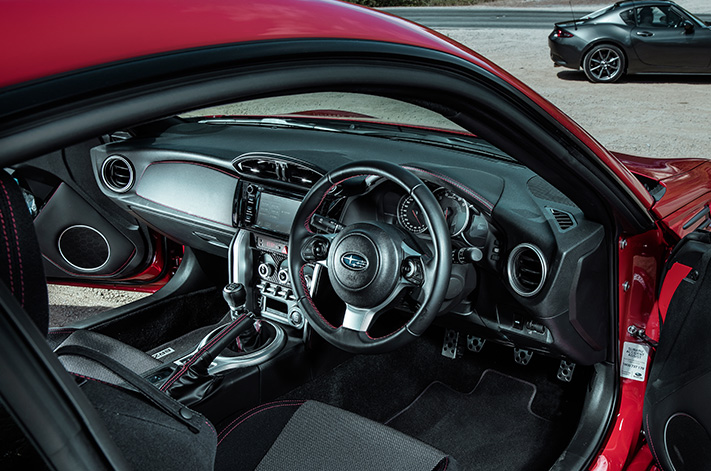
Some punters will only ever buy a Porsche, while others are fanatically devoted to the Toyota 86/Subaru BRZ ‘hachi-roku’ phenomenon that they wouldn’t look sideways at an MX-5. And yet others would only ever buy the Toyota (the inspiration behind the car) while it’s Subaru all the way for the rest (the builder and supplier of oily bits).
In MX-5 terms, the purest example is the 1.5-litre manual rag-top, though the fact the hard-lidded RF exists, and is destined to expand the MX-5’s fan base, deserves praise in itself.
And who can dispute the return of flying buttresses, the RF’s beautiful point of difference? Certainly no Jaguar XJ-S devotee.
But does the fact that the loveable RF demands the greatest compromise to fit into your life nudge it into third place?
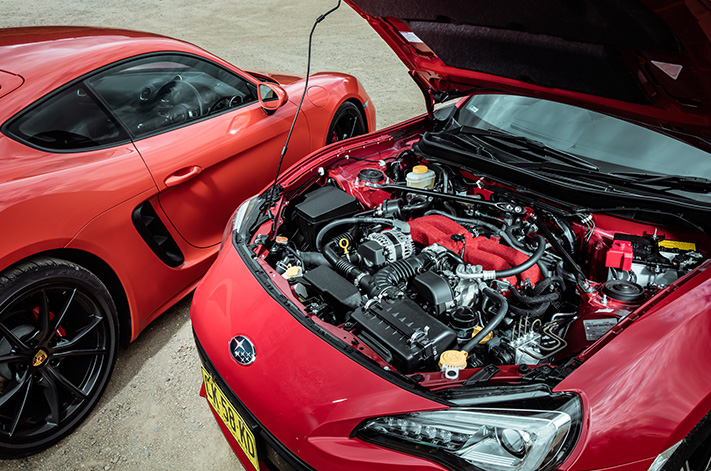
What’s even more surprising is just how seductive the Subaru BRZ still is, even at five years of age.
Its fundamental DNA and structural bones are just about perfect, making stuff like its ho-hum multimedia screen and unremarkable straight-line acceleration pale into insignificance.
Unlike the Porsche, the Subaru coupe isn’t about appendage measuring.
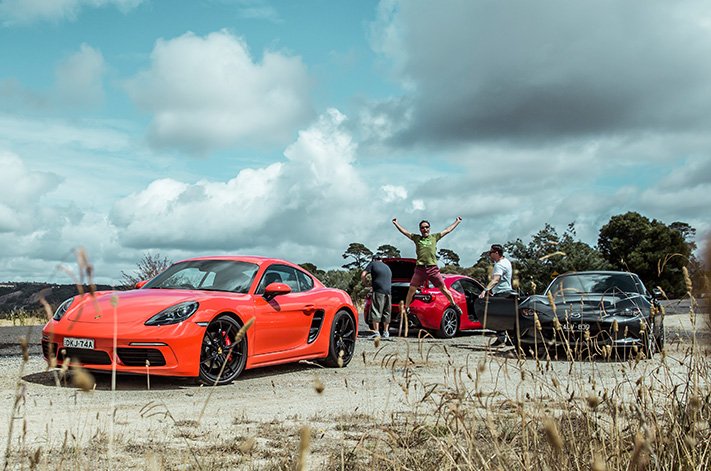
Then there’s the Cayman S. At an as-tested price of $180K, this delectable slice of orangeness is about as ‘everyman’ as a stock portfolio and a holiday pad in Byron, yet it’s also truly, madly, deeply aspirational – the sports car the MX-5 RF and BRZ would be if they grew up and scored a Joe Hockey-style ‘proper’ job.
Its broader dynamic repertoire kinda goes with the territory, but it’s the Cayman S’s phenomenal performance that puts it so far ahead of the Japanese coupes.
It’s so blindingly quick that after driving the other two, it takes your breath away. And, in my opinion, it loses almost nothing for being a boosted flat-four, yet gains a shedload of additional stomp and cred.
So while the BRZ is arguably the purest coupe of our time, and the MX-5 a deserving roadster legend, the Cayman S is simply a frigging great Porsche. And that speaks volumes, via smartphone or bush telegraph.
